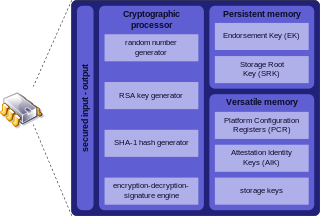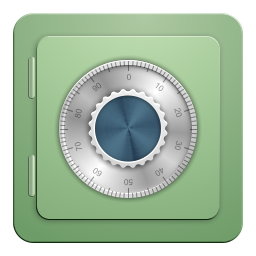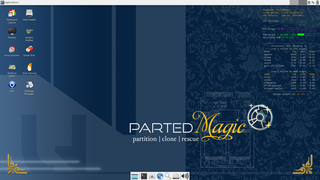Related Research Articles
Disk formatting is the process of preparing a data storage device such as a hard disk drive, solid-state drive, floppy disk, memory card or USB flash drive for initial use. In some cases, the formatting operation may also create one or more new file systems. The first part of the formatting process that performs basic medium preparation is often referred to as "low-level formatting". Partitioning is the common term for the second part of the process, dividing the device into several sub-devices and, in some cases, writing information to the device allowing an operating system to be booted from it. The third part of the process, usually termed "high-level formatting" most often refers to the process of generating a new file system. In some operating systems all or parts of these three processes can be combined or repeated at different levels and the term "format" is understood to mean an operation in which a new disk medium is fully prepared to store files. Some formatting utilities allow distinguishing between a quick format, which does not erase all existing data and a long option that does erase all existing data.

A flash drive is a data storage device that includes flash memory with an integrated USB interface. A typical USB drive is removable, rewritable, and smaller than an optical disc, and usually weighs less than 30 g (1 oz). Since first offered for sale in late 2000, the storage capacities of USB drives range from 8 to 256 gigabytes (GB), 512 GB and 1 terabyte (TB). As of 2023, 2 TB flash drives were the largest currently in production. Some allow up to 100,000 write/erase cycles, depending on the exact type of memory chip used, and are thought to physically last between 10 and 100 years under normal circumstances.

SystemRescue is a Linux distribution for x86-64 and IA-32 computers. The primary purpose of SystemRescue is to repair unbootable or otherwise damaged computer systems after a system crash. SystemRescue is not intended to be used as a permanent operating system. It runs from a Live CD, a USB flash drive or any type of hard drive. It was designed by a team led by François Dupoux, and is based on Arch Linux since version 6.0. Starting with version 6.0, it has systemd as its init system.
dd is a command-line utility for Unix, Plan 9, Inferno, and Unix-like operating systems and beyond, the primary purpose of which is to convert and copy files. On Unix, device drivers for hardware and special device files appear in the file system just like normal files; dd can also read and/or write from/to these files, provided that function is implemented in their respective driver. As a result, dd can be used for tasks such as backing up the boot sector of a hard drive, and obtaining a fixed amount of random data. The dd program can also perform conversions on the data as it is copied, including byte order swapping and conversion to and from the ASCII and EBCDIC text encodings.
Utility software is a program specifically designed to help manage and tune system or application software. It is used to support the computer infrastructure - in contrast to application software, which is aimed at directly performing tasks that benefit ordinary users. However, utilities often form part of the application systems. For example, a batch job may run user-written code to update a database and may then include a step that runs a utility to back up the database, or a job may run a utility to compress a disk before copying files..

Darik's Boot and Nuke, also known as DBAN, is a free and open-source project hosted on SourceForge. The program is designed to securely erase a hard disk until its data is permanently removed and no longer recoverable, which is achieved by overwriting the data with pseudorandom numbers generated by Mersenne Twister or ISAAC. The Gutmann method, Quick Erase, DoD Short, and DOD 5220.22-M are also included as options to handle data remanence. DBAN can be booted from a CD, DVD, USB flash drive or diskless using a Preboot Execution Environment. It is based on Linux and supports PATA (IDE), SCSI and SATA hard drives. DBAN can be configured to automatically wipe every hard disk that it sees on a system or entire network of systems, making it very useful for unattended data destruction scenarios. DBAN exists for x86 systems.
Data security means protecting digital data, such as those in a database, from destructive forces and from the unwanted actions of unauthorized users, such as a cyberattack or a data breach.

Norton Utilities is a utility software suite designed to help analyze, configure, optimize and maintain a computer. The latest version of the original series of Norton Utilities is Norton Utilities 16 for Windows XP/Vista/7/8 was released 26 October 2012.
Data remanence is the residual representation of digital data that remains even after attempts have been made to remove or erase the data. This residue may result from data being left intact by a nominal file deletion operation, by reformatting of storage media that does not remove data previously written to the media, or through physical properties of the storage media that allow previously written data to be recovered. Data remanence may make inadvertent disclosure of sensitive information possible should the storage media be released into an uncontrolled environment.
Undeletion is a feature for restoring computer files which have been removed from a file system by file deletion. Deleted data can be recovered on many file systems, but not all file systems provide an undeletion feature. Recovering data without an undeletion facility is usually called data recovery, rather than undeletion. Undeletion can both help prevent users from accidentally losing data, or can pose a computer security risk, since users may not be aware that deleted files remain accessible.

Disk Utility is a system utility for performing disk and disk volume-related tasks on the macOS operating system by Apple Inc.

Trusted Platform Module (TPM) is an international standard for a secure cryptoprocessor, a dedicated microcontroller designed to secure hardware through integrated cryptographic keys. The term can also refer to a chip conforming to the standard ISO/IEC 11889.
Anti-computer forensics or counter-forensics are techniques used to obstruct forensic analysis.

BestCrypt, developed by Jetico, is a commercial disk encryption app available for Windows, Linux, macOS and Android.
Data erasure is a software-based method of data sanitization that aims to completely destroy all electronic data residing on a hard disk drive or other digital media by overwriting data onto all sectors of the device in an irreversible process. By overwriting the data on the storage device, the data is rendered irrecoverable.
HDDerase is a freeware utility that securely erases data on hard drives using the Secure Erase unit command built into the firmware of Parallel ATA and Serial ATA drives manufactured after 2001. HDDerase was developed by the Center for Magnetic Recording Research at the University of California, San Diego. HDDerase is designed for command-line use only.
shred is a command on Unix-like operating systems that can be used to securely delete files and devices so that it is extremely difficult to recover them, even with specialized hardware and technology; assuming it's even possible to recover the file at all. It is a part of GNU Core Utilities. Being based on the Gutmann method paper, it suffers from the same criticisms and possible shortcomings.

Parted Magic is a commercial Linux distribution based on Slackware that comes with disk partitioning and data recovery tools. It is sold as a Linux-based bootable disk. The distribution's nomenclature is derived from the names of the GNU Parted and PartitionMagic software packages.
Redkey USB Ltd. is a British software company established in April 2018 after a crowfunding campaign on Kickstarter. The company specializes in creating proprietary utilities for secure data erasure. Its main product, the Redkey USB, is designed to securely erase data from a variety of storage devices.
References
- ↑ "BleachBit Features" . Retrieved 3 April 2016.
- ↑ "CCleaner Features" . Retrieved 3 April 2016.
- ↑ "DBAN / Blancco Feature Comparison". Archived from the original on 2 April 2016. Retrieved 3 April 2016.
- ↑ Elliot, Duncan (11 November 2009). "Using "dd" and "urandom" to write random data to a disk". Duncan Elliot's blog. IBM . Retrieved 17 March 2014.
- ↑ Hodgetts, Benjamin (4 December 2010). "Securely Wiping (Zero Writing) a Drive". Robot Butler. Retrieved 17 March 2014.
- ↑ "OS X: About Disk Utility's erase free space feature" . Retrieved 3 April 2016.
- ↑ "Appendix A: Erasure Methods" . Retrieved 31 January 2019.
- ↑ "HDDErase Readme" . Retrieved 3 April 2016.
- ↑ "kernel.org ATA wiki" . Retrieved 3 April 2016.
- ↑ "Parted Magic software components". Parted Magic software list. 3 April 2016.
- ↑ "Parted Magic source code". Archived from the original on 11 April 2016. Retrieved 3 April 2016.
- ↑ "Parted Magic Secure Erase". Parted Magic web site. Retrieved 3 April 2016.
- ↑ "Parted Magic Secure Erase". Parted Magic web site. Retrieved 3 April 2016.
- ↑ "shred invocation" . Retrieved 3 April 2016.
- ↑ "secure rm". SourceForge. Dice Holdings. 31 January 2014.